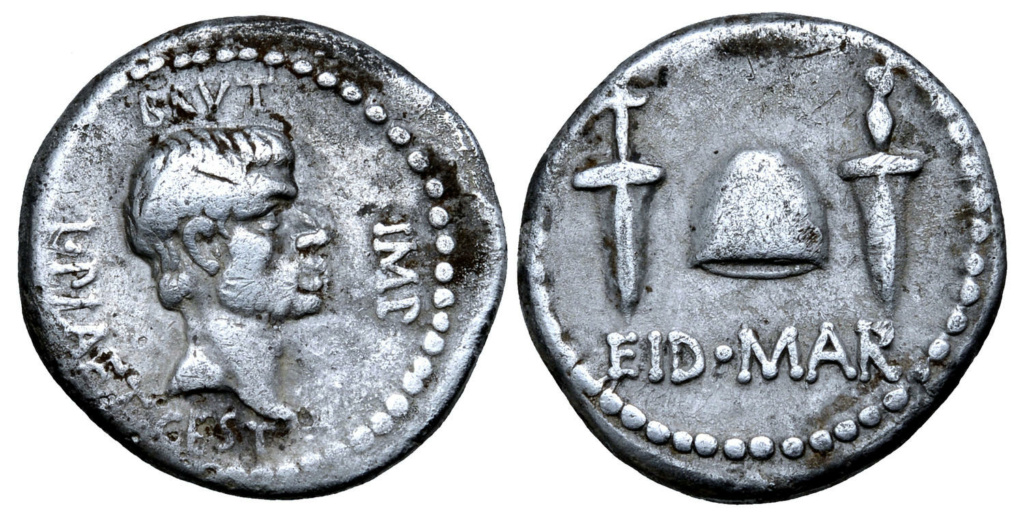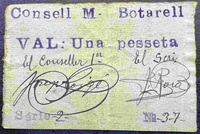Rombero
NOVUS


Cantidad de envíos : 2
• Actividad : 3
Fecha de inscripción : 28/05/2022
 |  Tema: Denario de Bruto. Eidibus Martiis (idus de marzo). Tema: Denario de Bruto. Eidibus Martiis (idus de marzo).  Sáb Mayo 28, 2022 11:28 pm Sáb Mayo 28, 2022 11:28 pm | |
| Roman Imperatorial Q. Servilius Caepio (M. Junius) Brutus AR Denarius. Military mint travelling with Brutus and Cassius in western Asia Minor or northern Greece, late summer-autumn 42 BC. L. Plaetorius Cestianus, moneyer. Bare head of Brutus right; BRVT above, IMP to right, L•PLAET•CEST around to left / Pileus between two daggers pointing downward; EID•MAR below. Crawford 508/3; Cahn 20c; CRI 216; Sydenham 1301; BMCRR East 68-70; RSC 15; Campana, Eidibus Martiis, 64, (O4/R9 [this coin]). 3.76g, 18mm, 12h.  About Very Fine; some very minor spots of corrosion on obv. Rare. From the Eucharius Collection; Privately purchased from a Swiss collection in the 1960s. Formed, we are told, mostly in the 1950s and 60s, the Eucharius Collection comprised over 400 silver coins of the Roman Republic, including numerous rarities. Unfortunately the collector responsible for amassing this group is no longer with us, and the present owner wishes it to remain anonymous, so this beautiful collection was named for the day on which it was consigned: December 8th, the feast day of Saint Eucharius. Presented in our Auction XI were 127 of the highest quality specimens; the remainder of the collection was dispersed through Roma Numismatics' E-Sales. This coin, undoubtedly the most valuable piece present in the collection and certainly the most iconic, was kept back until last by the present owner. Nothing resonates so deeply with those knowledgeable in ancient Roman coinage as the dramatic EID MAR type struck by Brutus in 42 BC, nor indeed is any type more sought after by connoisseurs. Herbert A. Cahn's 1989 study entitled Eidibus Martiis noted 56 examples in silver and two in gold. Though anecdotal comments suggest the extent of the surviving population of EID MAR denarii may approximate as many as one hundred specimens - a reasonably high figure for what is considered to be an extreme rarity - no other ancient coin type has inspired such admiration, fascination, disbelief and desire in the hearts of historians, numismatists and collectors. Foremost of the reasons for the exalted position of the type in the collective consciousness is its naked and shameless celebration of the murder of Julius Caesar two years earlier in 44 BC. This brutal and bloody assassination had been prompted by the well-founded belief among the Senate that Caesar intended to make himself king, which in truth he was already in all but name. By special decree of the Senate Caesar had been made dictator perpetuo - dictator in perpetuity - and granted the extraordinary and unprecedented honour of striking coins bearing his own likeness, thus breaking the ancient taboo of placing the image of a living Roman upon a coin. By these and other affronts to the traditional values and institutions of the Republic did Caesar seal his fate. On 15 March, 44 BC, in a room adjoining the east portico of the Theatre of Pompey, Caesar was stabbed twenty three times by the gang of Senators numbering over thirty and perhaps as many as sixty, men that Caesar called his friends, and of whom many had been pardoned by him on the battlefield and now owed their ranks and offices to him. The simple but bold reverse design employed by Brutus contains the three principal elements of this 'patriotic' act of regicide committed to liberate the Republic from monarchical tyranny. Most striking are the two daggers of differing design, the one symbolising that wielded by Brutus himself, the other that of Cassius his co-consipirator. These flank the pileus, the cap of Liberty as worn by the divine twins and patrons of Roman armies Castor and Pollux, and which was conferred upon all freed slaves as a mark of their emancipation. The legend EID MAR is the abbreviation of EIDIBVS MARTIIS – the Ides of March. Thus, in an act of unparalleled braggadocio, we are at once presented with the murder weapons used to slay Caesar, the precise date of the deed, and the motive. While the leaders of the Second Triumvirate Antony, Octavian and Lepidus embraced the practice of striking coins bearing their own images, the hypocrisy of Brutus placing his own portrait on the obverse of the EID MAR type cannot have been lost on the Liberator. Both a betrayal of his personal devotion to the ancient traditions of the Republic, and an emulation of the tyrant he had slain, it may well be that he was convinced into allowing his image to be co-opted by the Republican party as a rallying symbol for the swiftly approaching engagement between their legions and those of the Antony and Octavian. As a descendent of Lucius Junius Brutus, the founder and first consul of the Roman Republic, who in 509 BC had sworn on a bloody dagger to overthrow the unjust rule of the Tarquin kings, the clearly drawn parallels must have been heady propaganda to the Republican cause. |
|
Natxos7
MODERADOR

 
Cantidad de envíos : 9293
Localización : El Mundo
• Actividad : 10002
Fecha de inscripción : 15/04/2012
 |  Tema: Re: Denario de Bruto. Eidibus Martiis (idus de marzo). Tema: Re: Denario de Bruto. Eidibus Martiis (idus de marzo).  Sáb Mayo 28, 2022 11:42 pm Sáb Mayo 28, 2022 11:42 pm | |
| |
|
